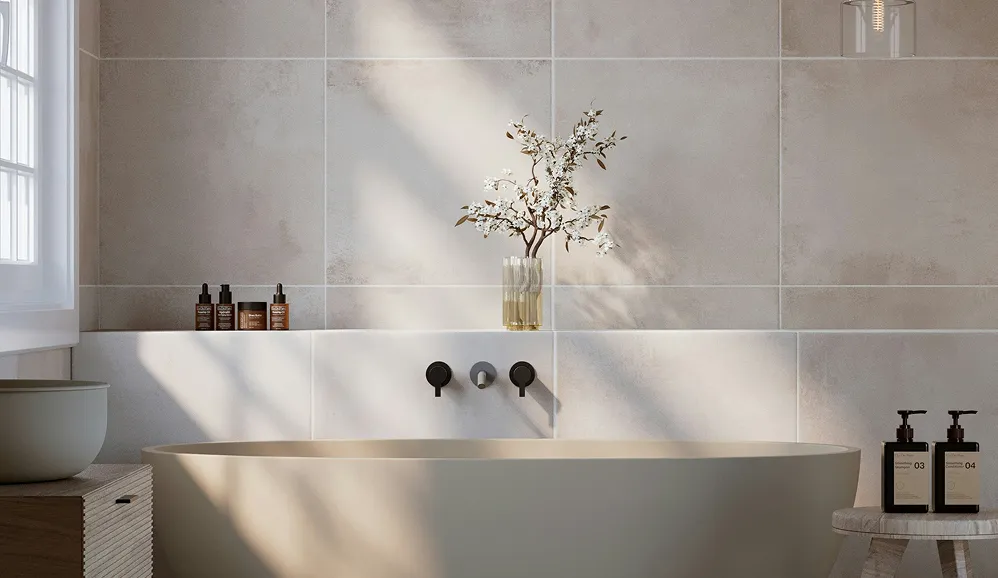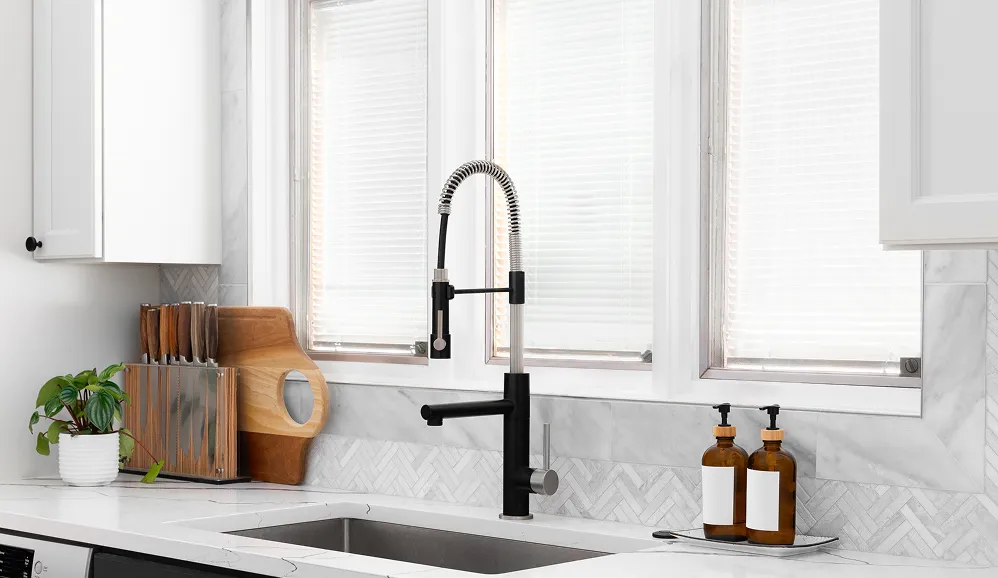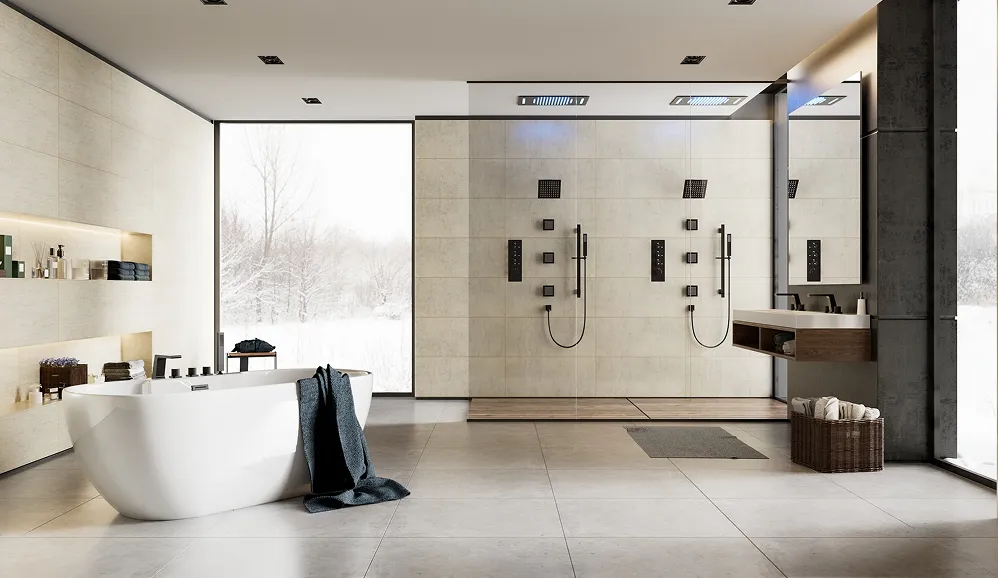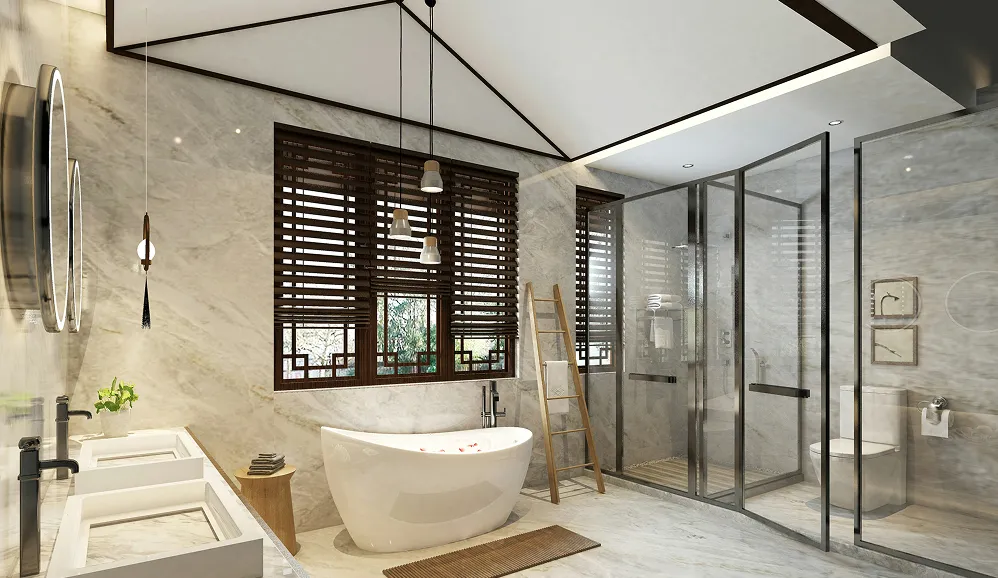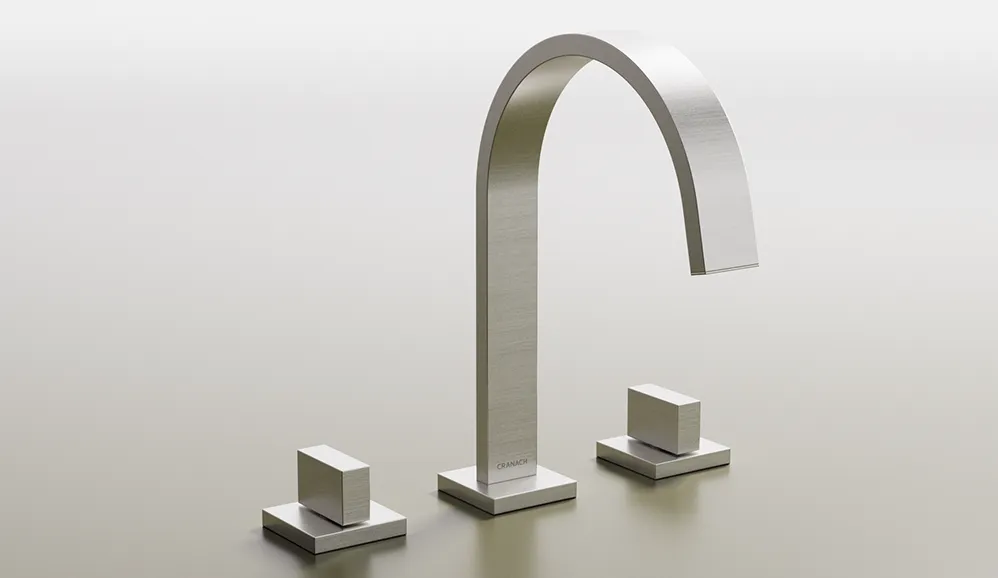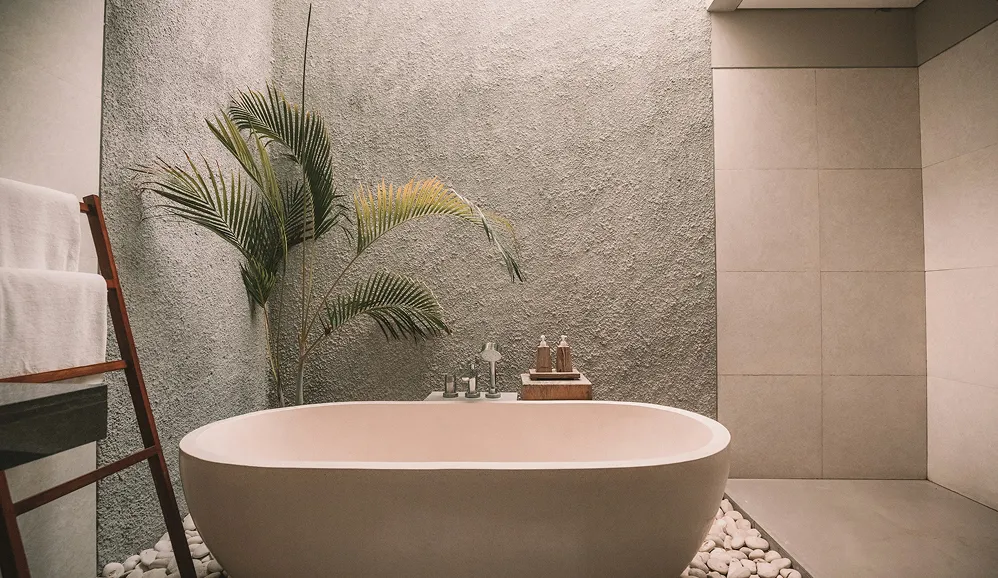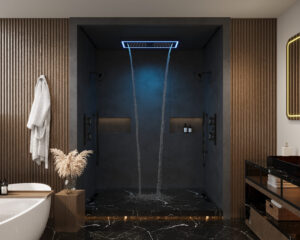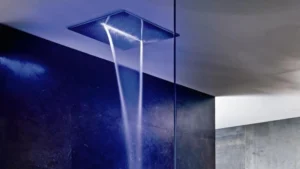Transform Your Bathroom Oasis in 2025
In recent years, the bathroom has evolved beyond merely serving a functional role. It is now considered a personal sanctuary, a space for relaxation and self-care. Understanding the latest bathroom design trends for 2025 is crucial for anyone involved in designing, building, or renovating this essential room. Whether you’re a homeowner dreaming of the perfect bathroom, a contractor planning a remodel, or an interior designer seeking fresh inspiration, staying informed is vital.
As we look toward 2025, bathroom design trends highlight the integration of spa-like features and smart technology, reflecting ever-changing lifestyles, technological advancements, and a growing focus on sustainability. Successful bathroom design seamlessly combines functionality, aesthetics, and personal style to create spaces that are both beautiful and practical. Traditionally, bathrooms have mirrored broader design trends, evolving from the ornate Victorian era to the minimalism of mid-century modern.
Today, personalization, eco-awareness, and global influences are shaping design. As highlighted by Better Homes and Gardens, bathroom design trends in 2025 are heading in exciting directions. This article explores the top ten trends, offering insights into the concepts, strategies, and products that transform bathrooms into stunning oases.
1. Biophilic Bathroom Design
Biophilic design in bathrooms is more than just adding a few plants. It involves creating a sanctuary that fosters wellness and relaxation by deeply integrating nature into your space. This trend, expected to dominate bathroom design trends in 2025, blurs the lines between indoors and outdoors. It uses natural materials, light, and elements to connect people with nature, enhancing overall well-being. This connection reduces stress, improves cognitive function, and boosts mood – essential benefits in our hectic modern lives. Thus, biophilic design stands out as a leading trend.
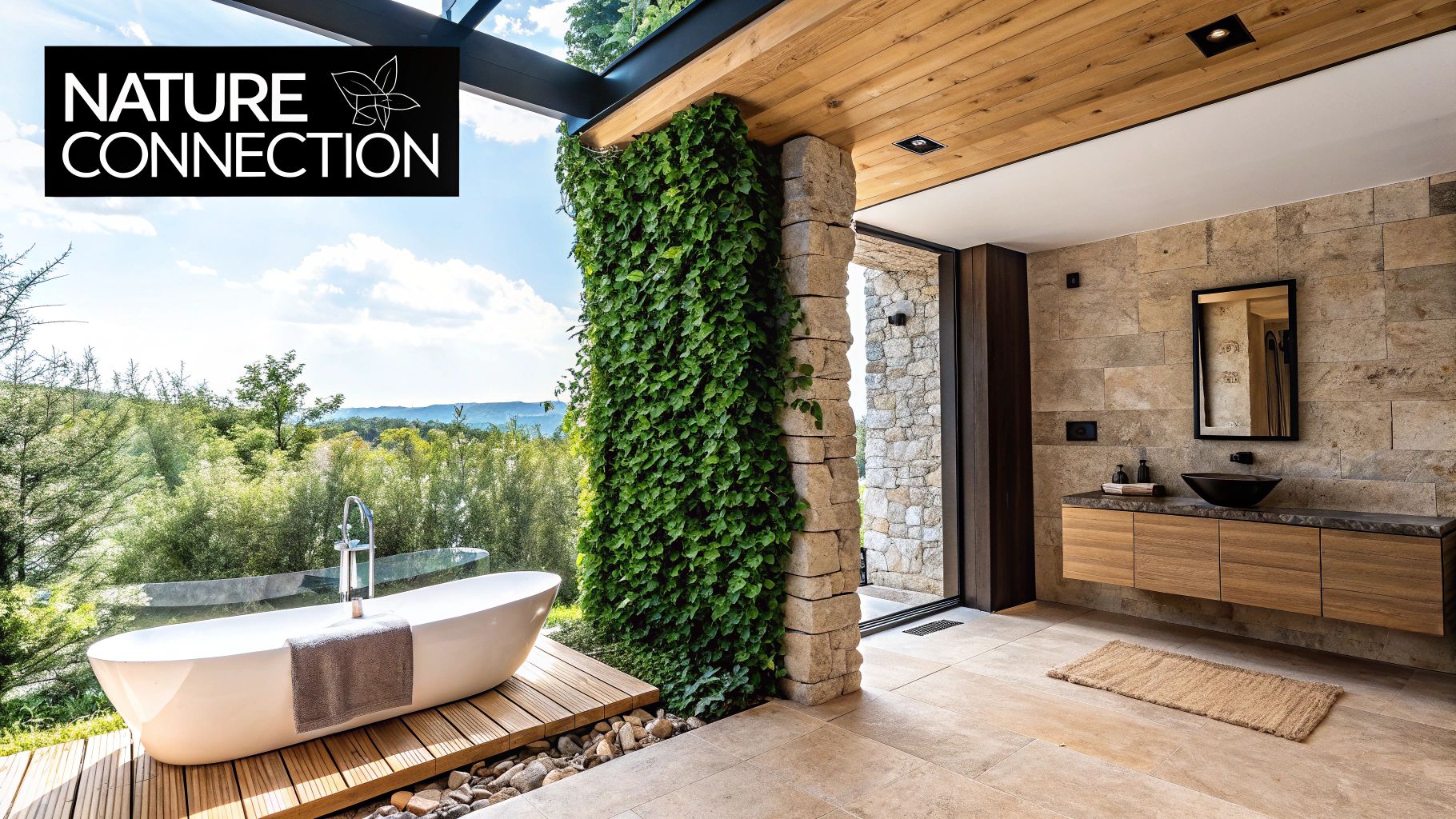
Key Features of a Biophilic Bathroom
-
Living Plants and Vertical Gardens: Adding greenery, from potted plants to vertical gardens, enhances air quality and visual appeal.
-
Natural Materials: Using materials like wood, stone, bamboo, and cork creates a tactile and visually grounding experience, reflecting the natural world.
-
Water Features: Rainfall showers, freestanding tubs, and small water features mimic natural water sources and create a spa-like atmosphere.
-
Natural Light: Maximizing natural light through skylights or large windows is crucial as it regulates our circadian rhythm and boosts vitamin D levels.
-
Organic Shapes and Patterns: Mimicking natural shapes and patterns, such as flowing lines and organic textures, strengthens the connection to the outdoors.
Pros of Biophilic Design
-
Improved Air Quality and Humidity Regulation: Plants naturally filter the air and help regulate humidity.
-
Calming, Spa-like Atmosphere: Natural elements create a serene and relaxing environment.
-
Mental Well-being and Stress Reduction: There is a direct link between exposure to nature and reduced stress.
-
Environmentally Conscious Approach: Using sustainable materials and promoting a connection to nature aligns with eco-conscious living.
-
Timeless Aesthetic: Biophilic design’s connection to nature gives it enduring appeal.
Tips for Implementing Biophilic Design
-
Choose Moisture-Loving Plants: Opt for plants that thrive in humidity, such as ferns, peace lilies, snake plants, and orchids.
-
Use Natural Stone: Incorporate natural stone like marble, slate, or granite for shower walls and flooring.
-
Seal Wood Properly: Ensure wood is sealed to protect it from moisture damage.
-
Maximize Natural Light: Maximize natural light and supplement with full-spectrum lighting to support plant growth.
-
Create a Maintenance Schedule: Establish a regular maintenance routine for living elements to ensure their health.
2. Smart Bathroom Technology
Smart bathroom technology is changing how we experience personal spaces by bringing digital advancements into our daily routines. This involves connecting bathroom fixtures and features to the Internet of Things (IoT), allowing for automation, personalization, and greater control. Smart bathrooms, equipped with voice-activated showers that preheat to your ideal temperature and self-cleaning toilets, are becoming commonplace.
This trend’s increasing popularity stems from the desire for more convenience, better hygiene, and efficient water and energy management, making it a significant part of bathroom design trends for 2025.
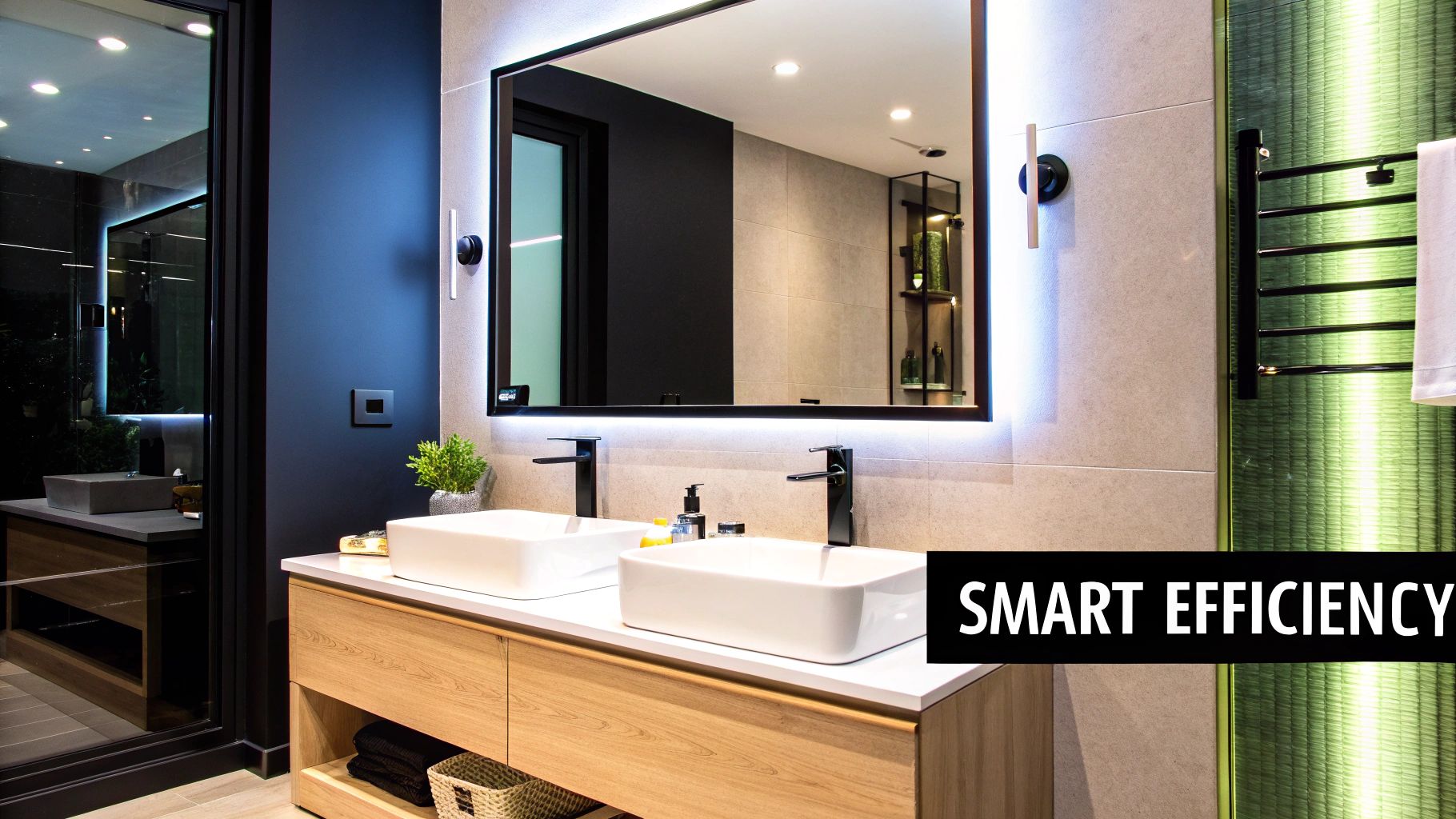
Smart Bathroom Features
Smart bathroom technology includes various features designed to improve user experience:
-
Voice-activated fixtures and lighting: Control water flow, temperature, and lighting with simple spoken instructions.
-
Digital shower controls with temperature presets: Set personalized shower experiences with pre-programmed settings for everyone in the household.
-
Smart mirrors with integrated displays and lighting: Catch up on news, weather, and other information while getting ready.
-
Self-cleaning toilets with touchless flushing: Improve hygiene and reduce the spread of germs.
-
Water usage monitoring systems: Track water consumption and detect potential leaks.
-
Leak detection and automatic shut-off valves: Avoid expensive water damage through automated leak detection and shut-off.
Pros and Cons of Smart Bathrooms
The advantages of using smart technology in your bathroom are numerous.
Pros:
-
Enhanced Convenience and Customization: Personalize your bathroom to fit your specific needs.
-
Improved Water and Energy Efficiency: Lower your utility bills with smart monitoring and control.
-
Better Hygiene: Touchless features minimize the spread of germs.
-
Increased Accessibility: Voice control and automation can significantly help elderly or disabled users.
-
Real-Time Monitoring: Gain insights into water usage and potential savings.
Tips for Implementation
-
Start Small: Begin with a few smart features instead of a full renovation.
-
Ensure Connectivity: Strong Wi-Fi and sufficient outlets are essential.
-
Choose Compatible Ecosystems: Select products that work with your preferred smart home system (e.g., Apple HomeKit, Google Home, Amazon Alexa).
-
Prioritize Waterproofing: Protect electronics in splash zones.
-
Ensure Manual Overrides: Have backup options for power outages.
By understanding the features, benefits, and potential downsides of smart bathroom technology, and by following these tips, you can design a modern, efficient, and customized bathroom. This technology, featured in publications like Better Homes & Gardens‘ 2025 bathroom trend forecasts, reflects the growing preference for personalized, convenient, and eco-friendly bathroom design.
3. Spa-Inspired Wellness Bathrooms
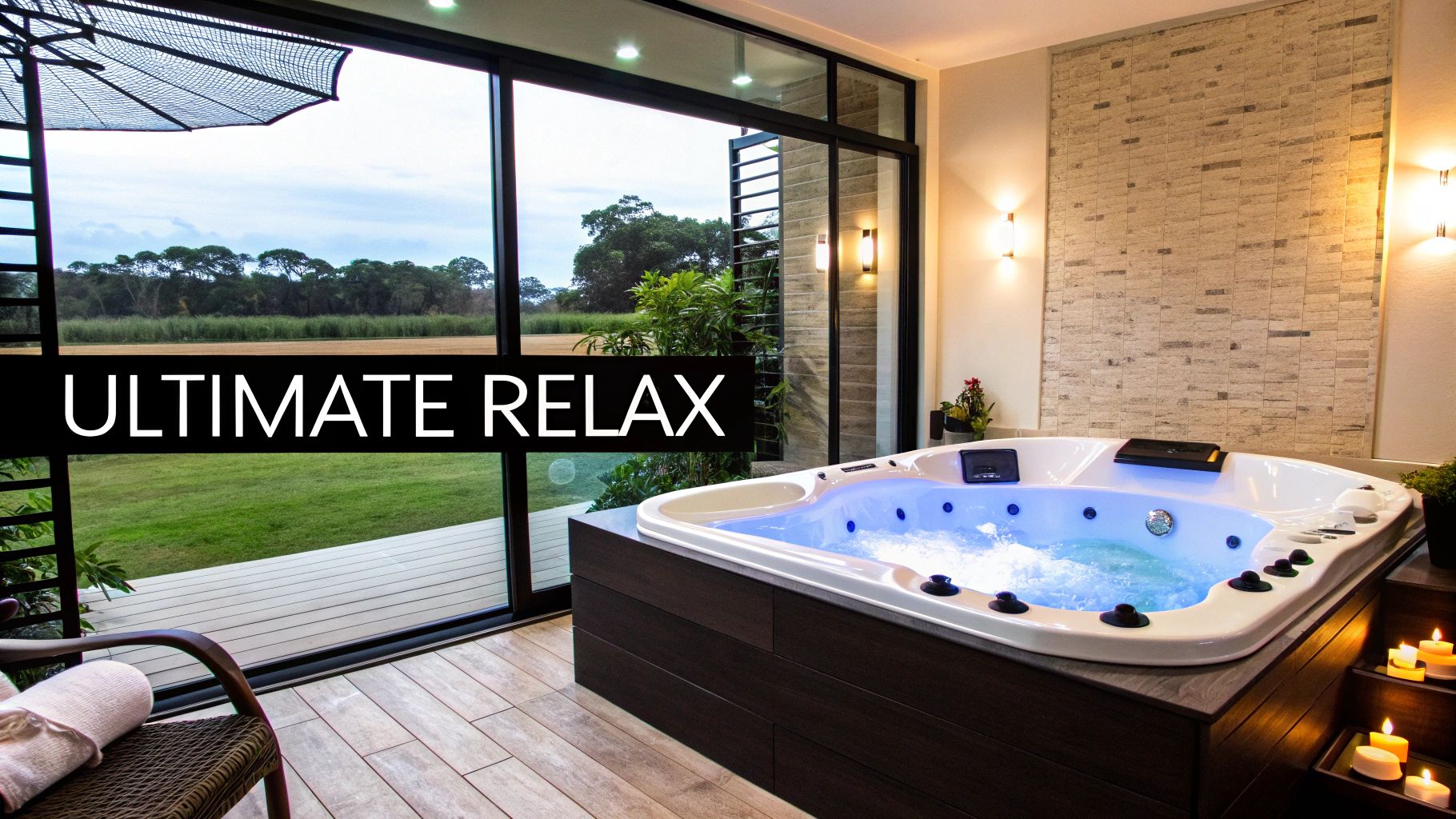
The modern bathroom is becoming much more than just a functional space. It’s transforming into a personal sanctuary for self-care and relaxation. Spa-inspired bathrooms perfectly embody this shift, turning everyday routines into a luxurious retreat.
This focus on therapeutic design, sensory details, and high-end amenities makes spa-inspired bathrooms a key trend in bathroom design trends for 2025. This reflects a broader societal focus on well-being, as seen in publications like Better Homes and Gardens‘ 2025 trend report. The growing demand for at-home wellness makes this trend a significant development, elevating the bathroom from purely utilitarian to a restorative space.
This isn’t just about adding a few candles and bath salts. Spa-inspired design integrates features that truly enhance both physical and mental well-being.
Key Elements of a Spa Bathroom
-
Hydrotherapy Tubs: These tubs, featuring air or water jets, deliver a targeted massage. They can ease muscle tension and improve circulation.
-
Steam Showers with Aromatherapy: Infusing steam with essential oils elevates relaxation and can promote respiratory health.
-
Infrared Saunas or Steam Rooms: These offer deeper detoxification and muscle relaxation right in your home.
-
Chromotherapy Lighting: Changing colored lights can shift mood and create a more immersive, sensory experience.
-
Sound Systems for Music Therapy: Integrated sound systems allow you to curate playlists for relaxation or energy boosts.
-
Luxury Shower Systems: Customizable shower experiences are possible with multiple spray settings, rainfall showerheads, and digital controls.
Pros of a Spa Bathroom
-
Daily Stress Relief: Easy access to spa-like amenities encourages regular relaxation and stress reduction.
-
Potential Health Benefits: These can include improved circulation, muscle relief, and respiratory support.
-
Increased Property Value: Luxury bathroom features can significantly boost a home’s resale value.
-
Personalized Wellness: Tailor your spa experience to your preferences without the cost of spa memberships.
-
Better Sleep and Well-being: Regular relaxation contributes to better sleep and an overall sense of well-being.
Tips for Implementation
-
Prioritize Key Elements: If space is limited, focus on one or two key features aligning with your needs and budget.
-
Noise Control: Consider noise levels for mechanical equipment like pumps and ventilation.
-
Ventilation: Proper ventilation is essential to prevent mold and mildew.
-
Low-Maintenance Materials: Choose durable, moisture-resistant materials.
-
Comfortable Seating: Incorporate comfortable seating for relaxation.
-
Storage: Ample storage for spa products keeps the space organized.
By carefully planning, homeowners, contractors, and designers can create spa bathrooms that offer tranquility and contribute to a healthier lifestyle.
4. Statement Bathroom Lighting
Bathroom lighting isn’t just practical anymore; it’s a major design element. Statement bathroom lighting elevates the entire room, transforming light fixtures into artistic centerpieces. Bathrooms become visually stunning sanctuaries. This trend, gaining rapid popularity as we head into 2025, highlights dramatic, sculptural, or unique lighting designs. These not only illuminate daily routines but also inject personality and luxury.
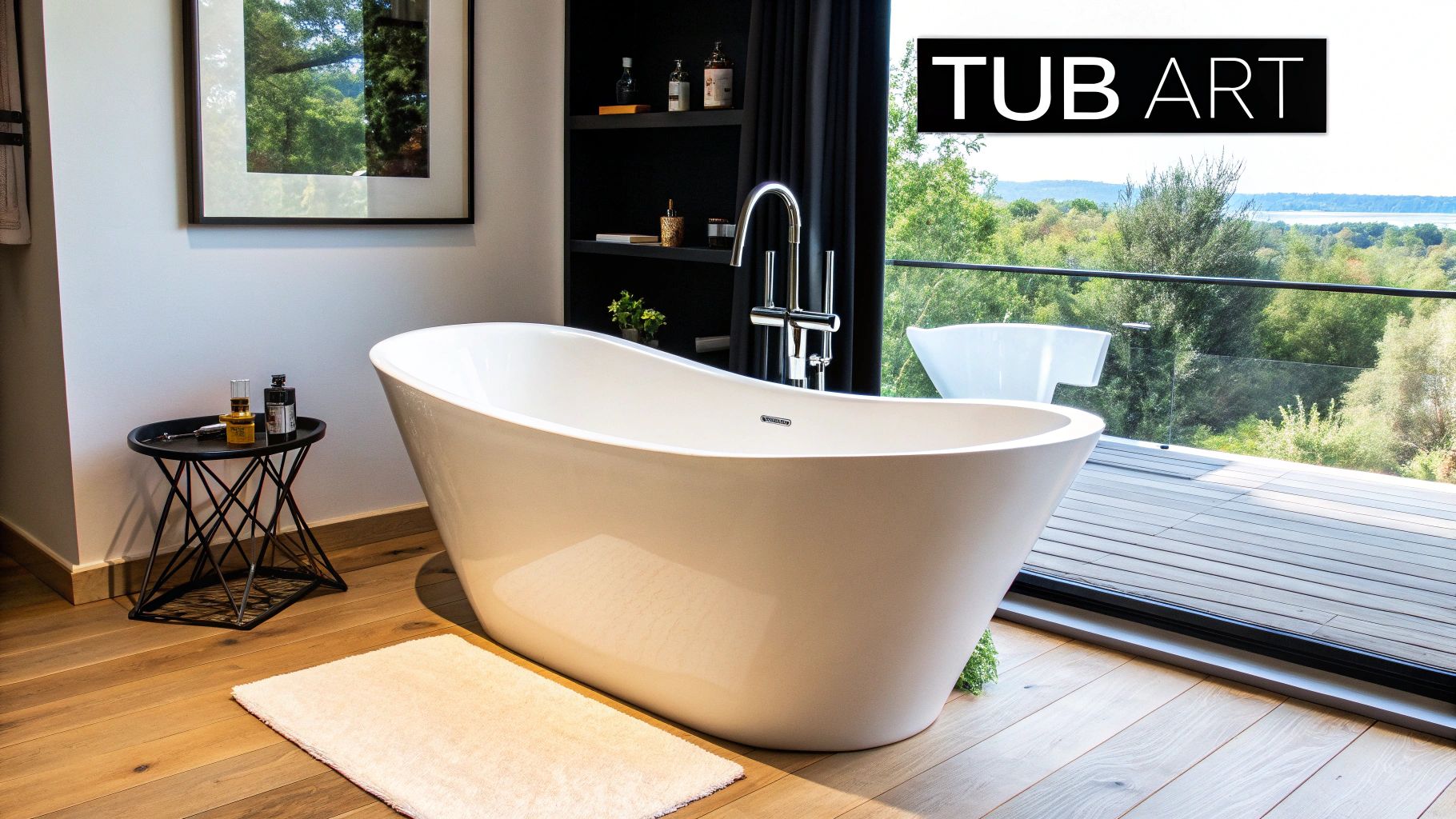
This trend’s rise comes from a growing desire to personalize and upgrade our homes. Bathrooms are now key spaces for self-care and relaxation. More and more designers have championed striking light fixtures. They’ve showcased the transformative power of lighting in high-end residential and hospitality projects. Their influence, along with features in publications like Better Homes & Gardens’ 2025 bathroom trend predictions, has cemented statement lighting as a must-have.
Features of Statement Bathroom Lighting
-
Dramatic pendant lights or chandeliers over bathtubs: These create a luxurious spa-like feel.
-
Backlit mirrors with integrated LED lighting: These provide functional task lighting while adding a touch of modern elegance.
-
Sculptural wall sconces: These serve as both light sources and decorative pieces.
-
Recessed lighting with color-changing capabilities: These allow for customized ambiance and mood setting.
-
Under-cabinet and toe-kick lighting: These add depth and visual interest.
-
Layered lighting schemes with multiple sources: These combine different types of lighting for a balanced and dynamic effect.
Pros of Statement Lighting
-
Visual Impact: Statement lighting transforms an ordinary bathroom into a stylish and captivating space.
-
Improved Functionality: Task-specific lighting ensures adequate illumination for grooming and other activities.
-
Mood Setting Flexibility: You can create a relaxing or energizing atmosphere.
-
Space Enhancement: Strategic lighting can make small bathrooms appear larger.
-
Easy Upgrade: Statement lighting updates a bathroom’s appearance without a major renovation.
Tips for Implementing Statement Lighting
-
IP Ratings: Ensure proper IP ratings for fixtures in wet areas.
-
Layered Lighting: Use ambient, task, and accent lighting sources for a balanced scheme.
-
Dimmers: Use dimmers to control mood and intensity.
-
Balance: Balance statement pieces with simpler elements to avoid overwhelming the space.
-
Mirror Reflections: Consider how fixtures will reflect in mirrors.
Statement bathroom lighting earns its spot on the 2025 bathroom trends list. It offers a powerful way to personalize and elevate this essential space. By considering the features, pros, cons, and tips provided, you can use the transformative power of light to create truly stunning and functional bathrooms.
5. Bold Bathroom Colors and Patterns
Say goodbye to the era of stark, all-white bathrooms. In 2025, vibrant colors and dynamic patterns are taking over, transforming these often-forgotten spaces into lively reflections of personal style. This trend moves away from the minimalist, neutral palettes of recent years and embraces saturated hues, striking contrasts, and captivating patterns. The bathroom is now a design focal point, not just a utilitarian room. This shift mirrors a larger trend of homeowners injecting more personality and joy into their homes.
This design philosophy uses color psychology and pattern play to create specific moods and emotionally resonant environments. Imagine a bathroom that energizes you with a bright yellow or calms you with a deep teal. This is the potential of bold color and pattern.
Key Features of This Trend
-
Jewel-Toned Walls and Cabinetry: Think deep emerald green, sapphire blue, ruby red, and amethyst purple.
-
High-Contrast Color Schemes: Dramatic combinations like black and white, navy and brass, or even coral and charcoal.
-
Statement Wallpapers: Large-scale patterns like tropical prints, geometric designs, or vintage-inspired motifs.
-
Tile Designs: Geometric and encaustic tiles add visual interest and texture to floors and walls.
-
Color-Blocking Techniques: Creating a dynamic look with blocks of contrasting colors.
-
Patterned Vanities and Furniture: Amplifying the personality of the space.
-
Colorful Fixtures and Hardware: From faucets and showerheads to cabinet pulls and towel bars, every detail counts.
Pros of Bold Bathroom Design
-
Personality: Creates memorable, distinctive spaces with a unique flair.
-
Self-Expression: Provides a canvas for your individual design vision.
-
Space Perception: Dark colors create a cozy feel, while light colors make a small bathroom feel larger.
-
Impactful Design: Turns even small powder rooms into stunning statements.
-
Social Media Ready: Creates a visually appealing backdrop for photos.
Tips for Implementing Bold Design
-
Test First: Use removable wallpaper or paint samples before committing.
-
Balance is Key: Pair bold choices with some neutral elements.
-
Focal Point: Use a statement pattern on one surface rather than throughout the entire room.
-
Lighting Matters: Consider natural and artificial light when choosing colors.
-
Start Small: Experiment in a powder room before tackling a primary bathroom.
-
Strategic Mirrors: Use mirrors to enhance and reflect statement patterns.
The growing desire for self-expression and a departure from minimalist aesthetics fuels the rise of bold bathrooms. Homeowners increasingly see their bathrooms as personal sanctuaries and spaces to express their individuality. For more inspiration and product ideas, check out these shop the looks. By embracing bold colors and patterns, you can transform your bathroom into a truly unique and memorable space.
6. Freestanding Bathtubs as Focal Points
Freestanding bathtubs have evolved beyond mere functionality. In 2025, they’re sculptural centerpieces that define a bathroom’s entire aesthetic. No longer just a fixture, the freestanding tub is a statement piece, anchoring the room’s design and evoking the luxurious atmosphere of a high-end spa. This trend highlights the tub as an art object, strategically placed to maximize its impact – be it by a window, in the room’s center, or wherever plumbing permits.
This shift reflects a growing desire for creating personal sanctuaries within the home. Homeowners are increasingly seeking spa-like elements. The freestanding tub perfectly embodies this aspiration, its placement and design transforming the bathroom into a private retreat.
Features and Benefits
-
Sculptural Designs: From classic to contemporary, a wide array of styles caters to diverse preferences.
-
Strategic Placement: Positioning in room centers or near windows maximizes visual impact and enhances the experience.
-
Complementary Fixtures: Floor-mounted fillers complement the elegant aesthetic.
-
Platform Installations: Elevated or slightly sunken designs add visual interest.
-
Enhanced Comfort: Freestanding tubs are often deeper and more comfortable.
-
Increased Home Value: These tubs elevate the perceived luxury and value of a bathroom.
7. Sustainable and Eco-Friendly Bathroom Solutions
In 2025, bathroom design is about more than just aesthetics. It’s about making responsible choices. Sustainable and eco-friendly bathroom solutions are taking center stage, proving that environmental consciousness doesn’t have to compromise style or function. A growing awareness of our environmental impact and a desire for beautiful, functional bathrooms that minimize resource use and carbon footprint. This isn’t a passing trend; it’s a fundamental shift in how we approach design and renovation.
This movement goes beyond simply using green products. It’s a holistic approach encompassing everything from the materials we use to how we consume water and energy.
Key Features Driving the Sustainable Bathroom Trend
-
Water-saving fixtures: Low-flow toilets, faucets, and showerheads dramatically reduce water usage without sacrificing performance. Dual-flush toilets and even composting toilets offer further conservation.
-
Energy-efficient systems: From ENERGY STAR certified lighting to solar-powered water heaters, energy efficiency is key. Insulating hot water pipes also leads to significant savings.
-
Sustainable materials: Reclaimed wood, recycled glass, and rapidly renewable resources like bamboo are replacing traditional materials. Low- or no-VOC paints and finishes minimize harmful chemical emissions, creating healthier indoor air.
-
Smart technology: Smart water monitoring systems detect leaks and track usage, empowering homeowners to conserve more effectively.
-
Greywater recycling systems: These systems reuse water from showers and sinks for irrigation, further reducing water consumption.
Benefits of Sustainable Bathroom Design
Embracing sustainable bathroom design offers a wealth of advantages:
-
Reduced environmental impact: Lower water and energy consumption means a smaller carbon footprint and less strain on natural resources.
-
Lower utility bills: Water and energy savings directly reduce monthly expenses.
-
Healthier indoor air quality: Low-VOC paints and finishes create better indoor air quality.
Tips for Implementing Sustainable Bathroom Solutions
-
Prioritize high-impact changes: Start with water-saving fixtures for immediate impact.
-
Look for certifications: WaterSense and ENERGY STAR certifications guarantee efficiency standards.
-
Consider the full lifecycle: Think about the environmental impact of materials from production to disposal.
-
Insulate hot water pipes: This is a simple and effective energy-saving measure.
Ready to Embrace the Future of Bathroom Design?
From the natural embrace of biophilic design to the seamless integration of technology, bathroom design trends 2025 showcase personalized sanctuaries designed for both functionality and well-being. We’ve explored key concepts like spa-inspired serenity, statement lighting, bold colors and patterns, freestanding bathtubs, and the increasing importance of sustainable solutions. Visit us at Cranach and discover the perfect faucet to complete your vision.

